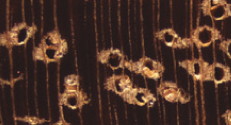JM - Tropical Wood
Sucupira
- Species
Diplotropis purpurea (Rich.) Amshoff
- Family
Fabaceae
- Characteristics
The tree can grow up to 40 meters in height and has undeveloped buttresses. The wood lacks characteristic odor or taste. The sapwood is clearly differentiated from the heartwood, which, although initially dark brown, becomes lighter following exposure. Whilst very resistant to fungi and termite attack, the wood is susceptible to marine borers.
- Technical recommendations
The wood is moderately difficult to saw, so tape saws with stellite tips are recommended. It is suitable for cutting decorative veneers.
When straight, the grain facilitates even brushing; but when interlocked, the flat surfaces may be left with flaws. The wood responds well to nailing, although working with manual tools can be difficult.
- Uses
The wood is used in home construction and for interior furniture and carpentry (mainly cabinets), but is so versatile that its uses also include sleepers, moldings, turning, packaging, laminates, plywood, and musical instruments. At a local level is also used for crafts.



- Technical properties
Basic density
0.80 g/cm³
Tangential shrinkage
7.4%
Radial shrinkage
5.3%
T/R ratio
1.4
Bending modulus of elasticity
204667 kg/cm²
Breakage modulus of elasticity
997 kg/cm²
Parallel compression (RM)
459 kg/cm²
Perpendicular compression (ELP)
84 kg/cm²
Grain parallel cut
135 kg/cm²
Hardness on the sides
973 kg/cm²
Hardness on the sides
2.90 kg-m
Newsletter
[mc4wp_form id="533"]
Species
© All Copyright 2024 by Jm Tropical Wood


